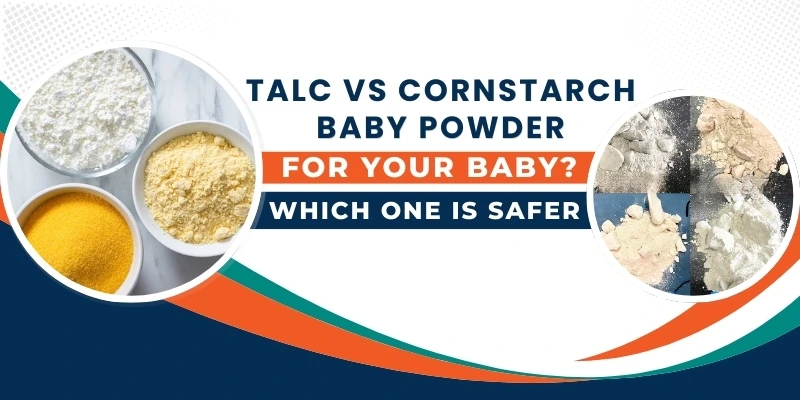
Talc vs Cornstarch: Which Baby Powder is Safer?
When it comes to keeping your baby dry and comfortable, baby powder is often a go-to solution. But with rising concerns about product safety, parents today are asking a critical question: talc vs cornstarch baby powder— which is safer? This debate isn’t just about preference; it’s about your baby’s health and long-term wellbeing. Let’s break down the differences, risks, and benefits of each.
What Is Talc?
Talc is a naturally occurring mineral made up of magnesium, silicon, and oxygen. It’s long been used in baby powders because of its excellent moisture-absorbing properties and silky texture. However, talc has come under scrutiny due to concerns about contamination with asbestos, a known carcinogen. While cosmetic-grade talc is supposed to be asbestos-free, some lawsuits and studies have linked long-term talc use to health risks, particularly ovarian cancer and respiratory issues.
What Is Cornstarch?
Cornstarch is a natural carbohydrate extracted from corn. It also absorbs moisture and helps reduce friction, making it a popular alternative to talc in baby powders. Unlike talc, cornstarch particles are larger and less likely to be inhaled deeply into the lungs, which may reduce the risk of respiratory irritation.
Key Differences: Talc vs Cornstarch Baby Powder
| Feature | Talc | Cornstarch |
|---|---|---|
| Origin | Mineral-based | Plant-based |
| Safety Concerns | Potentialasbestos contamination respiratory risks | Risk of yeast growth in moist areas, but generally safer |
| Particle Size | Fine, easily inhaled | Larger, less airborne |
| Skin Suitability | Can cause irritation in some | Gentler on sensitive skin |
| Natural/Organic Options | Limited | Widely available |
Safety Concerns & Legal Battles
The main concern with talc is its potential contamination with asbestos, which has led to numerous high-profile lawsuits claiming that prolonged use of talc-based powders may contribute to serious health issues, including cancer. Although not all studies agree, the controversy has been enough for many healthcare professionals to recommend caution or avoidance of talc altogether.
Cornstarch, on the other hand, does not carry the same legal baggage. Its main concern lies in its potential to feed yeast infections if not cleaned properly, particularly in warm, moist environments like diapers.
Which One Should You Choose?
If your priority is minimizing any possible health risks, cornstarch baby powder is generally considered the safer option. It’s plant-based, gentle on sensitive skin, and doesn’t carry the same respiratory or cancer-related concerns as talc. Many pediatricians and dermatologists now recommend cornstarch-based products as a safer alternative.
That said, every baby is different. Some may have sensitivities to corn-based ingredients. When in doubt, it’s always best to do a patch test or consult your pediatrician.
Conclusion
The talc vs cornstarch baby powder debate boils down to one thing: safety. While talc has a long history of use, growing evidence and consumer awareness are shifting preferences toward cornstarch alternatives. With so many talc-free and natural options now available, choosing a product that aligns with your baby’s health and your peace of mind is easier than ever.